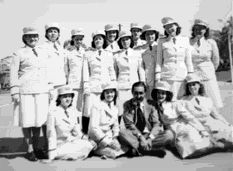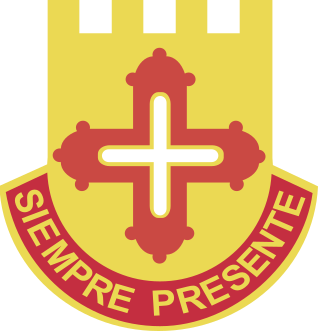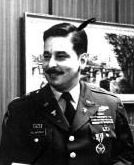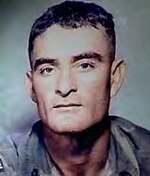
Carlos James Lozada was a member of the United States Army who was one of five Puerto Ricans who received the Medal of Honor during the Vietnam War.

Captain Eurípides Rubio was a United States Army officer and one of nine Puerto Ricans who were posthumously awarded the United States' highest military decoration for valor, the Medal of Honor, for actions on November 8, 1966, during the Vietnam War. Rubio was a member of the United States Army, Headquarters & Headquarters Company, 1st Battalion, 28th Infantry Regiment, 1st Infantry Division, Republic of Vietnam.

Sergeant First Class Modesto Cartagena de Jesús was a member of the United States Army who served in the 65th Infantry Regiment, a military regiment consisting of Puerto Rican enlisted soldiers and officers from the continental United States also known as "The Borinqueneers," during World War II and the Korean War, becoming the most decorated Hispanic soldier in that war. He was the most decorated Puerto Rican soldier in history.

The recorded military history of Puerto Rico encompasses the period from the 16th century, when Spanish conquistadores battled native Taínos in the rebellion of 1511, to the present employment of Puerto Ricans in the United States Armed Forces in the military campaigns in Afghanistan and Iraq.

Puerto Rico National Cemetery is a United States national cemetery located in the city of Bayamón, in the Commonwealth of Puerto Rico. It encompasses 108.2 acres (43.8 ha) of land, and at the end of 2005, had 44,722 interments. Until 2021, it was the only United States National Cemetery in Puerto Rico. A second United States National Cemetery was built in Morovis, Puerto Rico because the cemetery in Bayamón has reached its capacity.

Sergeant First Class Agustín Ramos Calero was awarded 22 decorations and medals from the U.S. Army for his actions during World War II and the Korean War, thus becoming the most decorated Puerto Rican and Hispanic soldier in the United States military during that war.

Puerto Ricans have served as members of the United States Armed Forces and have fought in every major conflict in which the United States has been involved from World War I onward. Many Puerto Ricans, including those of Puerto Rican descent, have distinguished themselves during combat as members of the five branches of the U.S. Military, the Army, Marines, Navy, Air Force and the Coast Guard.

The Puerto Rico National Guard (PRNG) –Spanish: Guardia Nacional de Puerto Rico– is the national guard of the U.S. Commonwealth of Puerto Rico. The Constitution of the United States specifically charges the National Guard with dual federal and state missions, which includes to provide soldiers and airmen to the United States Army and U.S. Air Force in national emergencies or when requested by the president of the United States, and to perform military operations at the state level or any other lawful service as requested by the governor of Puerto Rico. The PRNG responds to the governor of Puerto Rico, who serves as its commander in chief and imparts orders with the Puerto Rico adjutant general acting as conduit, and its local mission is to respond as requested in military or civilian tasks. Abroad, its main function is to train a reserve capable of providing additional personnel in a war scenario.

Alfonso "Tito" Auger Vega is a Puerto Rican musician best known for being the lead singer of the Rock en Español band Fiel a la Vega. Auger is also the band's main songwriter, together with Ricky Laureano.

Puerto Ricans and people of Puerto Rican descent have participated as members of the United States Armed Forces in the American Civil War and in every conflict which the United States has been involved since World War I. In World War II, more than 65,000 Puerto Rican service members served in the war effort, including the guarding of U.S. military installations in the Caribbean and combat operations in the European and Pacific theatres.

Raúl G. Villaronga was a United States Army officer who was the first Puerto Rican mayor of a Texas city. He served as mayor of Killeen, Texas, for three consecutive terms, from 1992 to 1998.
Commencing with World War I, Puerto Ricans and people of Puerto Rican descent have participated as members of the United States Armed Forces in every conflict in which the United States has been involved. Accordingly, thousands of Puerto Ricans served in the Armed Forces of the United States during the Vietnam War, also known as the Second Indochina War. Hundreds of them died, either killed in action (KIA) or while prisoners of war (POW). The Vietnam War started as a Cold War, and escalated into a military conflict that spread to Vietnam, Laos, and Cambodia from 1959 to April 30, 1975.

The 65th Infantry Regiment, nicknamed "The Borinqueneers" during the Korean War for the original Arawak Indian name for Puerto Rico (Borinquen), is a Puerto Rican regiment of the United States Army. The regiment's motto is Honor et Fidelitas, Latin for Honor and Fidelity. The Army Appropriation Bill created by an act of Congress on 2 March 1899 authorized the creation of the first body of native troops in Puerto Rico. On 30 June 1901, the "Porto Rico Provisional Regiment of Infantry" was organized. On 1 July 1908, Congress incorporated the regiment into the Regular Army as the Puerto Rico Regiment of Infantry, United States Army. On 14 May 1917, the regiment was activated and additional men were assigned, with the unit being sent to serve at Panama. On 4 June 1920, the regiment was renamed 65th Infantry. During World War II, the regiment saw action throughout Europe, especially France and Germany, participating in Naples-Foggia, Rome-Arno and Rhin. Several Purple Hearts were awarded posthumously to members of the 65th Regiment.

Camp Las Casas was a United States military installation established in Santurce, Puerto Rico in 1904. The camp was the main training base of the "Porto Rico Regiment of Infantry," a segregated U.S. Army Regiment which was later renamed the "65th Infantry Regiment." The base continued in operation until 1946, when it was closed.

Antonio Santiago Rodríguez, nicknamed Tony the Marine, is an American Marine veteran, writer, and military historian from New York City, focused mostly on the military history of Puerto Rico and its service members.

Félix Modesto Conde Falcón was a United States Army soldier and a recipient of the Medal of Honor. Born in Juncos, Puerto Rico, he joined the United States Army in April 1963 in Chicago, Illinois. He was killed during combat operations in Ap Tan Hoa, South Vietnam, on April 4, 1969. He was posthumously awarded the Medal of Honor by President Barack Obama in a March 18, 2014 ceremony in the White House. The award comes through the Defense Authorization Act which called for a review of Jewish American and Hispanic American veterans from World War II, the Korean War and the Vietnam War to ensure that no prejudice was shown to those deserving the Medal of Honor.

Private Demensio Rivera was a United States Army veteran of the Korean War who was awarded the Distinguished Service Cross; the award was upgraded in 2014, decades after his death, to the Medal of Honor.
Trio Vegabajeño was a legendary Puerto Rican popular music trio that existed from 1943 to the early 80s. This group marked an era of popular music in Puerto Rico. When trios were very popular in the Americas, Trio Vegabajeño was considered the ambassadors from Puerto Rico.


















